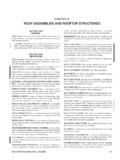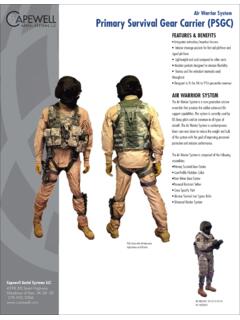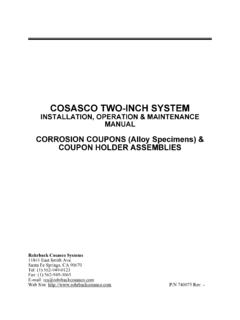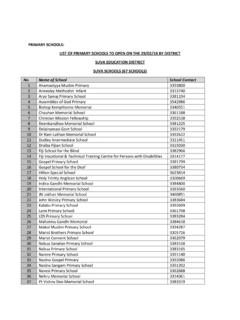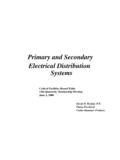Transcription of ACCELERATION FACTORS AND THERMAL CYCLING TEST …
1 Clech, SMTAI 05 Page 1 of 17 ACCELERATION FACTORS AND THERMAL CYCLING TEST efficiency FOR LEAD-FREE SN-AG-CU assemblies Jean-Paul Clech EPSI Inc. Montclair, New-Jersey, USA Paper (copyright EPSI Inc. 2005) was presented at SMTA International, Chicago, IL, Sept. 25-29, 2005 ABSTRACT This paper reports on the development and application of a SAC THERMAL CYCLING solder joint reliability model. The strain-energy based model is used to study the effect of ramp rates, mean temperature, dwell times and temperature profile (sine vs. trapeze-like cycle) on SAC solder joint life. The model captures dwell time effects accurately. A detailed study of dwell time and ramp rate effects shows how accelerated THERMAL CYCLING profiles can be optimized to improve test efficiency . Other application examples illustrate the impact of component parameters - global mismatch in Coefficients of THERMAL Expansion (CTEs) and maximum Distance to Neutral Point (DNP) - on ACCELERATION FACTORS .
2 Key words: Lead-free solder joint reliability, SAC life prediction model, dwell time, mean temperature, ramp rate effects, ACCELERATION FACTORS and their component dependency. INTRODUCTION Statements are often made to the effect that lead-free solders are more (or less) reliable than standard SnPb solder. These general statements are incomplete when the lead-free alloy composition is not specified and when product information and use conditions are left out of the equation. Reliability being defined as the ability of a product to survive field conditions for a specified period of time, the reliability assessment of lead-free assemblies calls for quantitative estimates of solder joint lives under relevant use conditions. This assessment can be performed in one of two ways: 1) by making absolute life predictions using an established predictive model; 2) by extrapolating accelerated test results to field conditions using an appropriate ACCELERATION Factor (AF).
3 While accelerated testing provides raw failure data for model calibration and/or validation, the reliability assessment of lead-free board assemblies is not complete until the above assessment has been performed. AFs are defined as the ratio of cycles to failure in the field to cycles to failure in test. Cycles to failure used in AF calculations are estimated upfront - prior to testing and product deployment - using a life prediction model. The reason for this is that very few organizations, if any, can afford to wait for field returns to validate predictions of cycles to failure under field conditions. A variety of solder joint life prediction techniques has been available for decades for SnPb assemblies . However, model development for lead-free assemblies is relatively recent. While the author is not aware of any life prediction capability for SnBi soldered assemblies , at least a dozen different models including the one presented in this paper - have been developed in the last two years for the more popular SnAgCu solder alloys [1-11].
4 The models are analytical, one-dimensional strain-energy based (as in the present paper), and strain or strain-energy based Finite-Element (FE) models. Examples of application and validation of the FE-based methodology in [9] are given in [12, 13]. Advantages and disadvantages of each model need to be weighed in carefully based on their scope of application, accuracy, cost of analysis, and speed of execution. For example, FE-based life predictions, which are typically carried by skilled analysts, take from a couple of hours to one day of computational time on a workstation, whereas algebraic or one-dimensional model execute almost instantaneously on standard computing equipment. FE models also require special consideration of element size effects since stresses and strain energy keep rising as the FE mesh is refined at the edge of solder joint interfaces. On the other hand, the FE approach is the most appropriate method when subtle geometric or material details (e.)
5 G, solder joint voids, intermetallics) need to be included in the analysis. This paper presents work in progress on a one-dimensional, strain energy model for SAC soldered assemblies . In its present stage of development, the model only handles shear stresses and strains that arise in solder joints due to the global THERMAL expansion mismatch between surface mount circuit boards and components. A similar capability has been developed to account for the contribution of local CTE mismatches in to the total (local + global) cyclic strain energy. This latter part of the model is still undergoing validation and will be reported on in a future publication. As such, the present model applies only to leadless components with a Clech, SMTAI 05 Page 2 of 17 small contribution of local CTE mismatches to cyclic strain energy. STRAIN-ENERGY BASED MODELS + + + + + CREEP STRAIN ENERGYCYCLIC LIFE (CYCLES)SAC, Schubert et al, ECTC ' , Syed, ECTC '04 Lau et al.
6 , ECTC '04 SAC: N50% = / on 12 data points with THERMAL CYCLING lives in approximate range 200 to 10000 cyclesSAC: = 345 / on 12 data points with THERMAL CYCLING lives in approximate range 100 to 10000 cyclesSAC: N = / on 9 data points (roomtemperature mechanical fatigueat test frequency of 122 cycles /minute) with cyclic lives in approximate range 250 to 1500 cycles Figure 1: Life vs. strain energy correlations from [5, 9, 10] for SAC assemblies . Figure 1 is a plot of three independent correlations of cyclic lives versus strain energy [5, 9, 10] for SAC solder joints of composition near that of SAC387 and SAC396 alloys ( wt. Ag, wt. Cu). The two correlations of THERMAL CYCLING data [9, 10] are each based on 12 data points that cover almost two orders of magnitude on the life and strain energy axis. Their slopes are close to 1. The correlation of isothermal (room temperature) mechanical fatigue data [5] is based on 9 data points over less than one order of magnitude in cyclic lives.
7 The slope of this correlation is , which is in the range: -1 = to -1 = -2, given in [14] for isothermal mechanical fatigue of engineering metals. + + + + + +01 STRAIN ENERGY (MPa) joint / A (cycles / in2)Slope = - data points2X Figure 2: Life / strain energy correlation for leadless SAC assemblies . Strain energy is obtained from hysteresis loops computed with one-dimensional solder joint shear strain model. Our present correlation of SAC THERMAL CYCLING failure data, shown in Figure 2, is given as: mJOINTWCA = (1) where JOINT is the characteristic life on a per joint basis (using Weibull failure distributions from a population of critical solder joints as opposed to failure distributions for a population of components), A is the solder joint load bearing or crack area, C is a constant, W is the cyclic strain energy density obtained from the area of stress / strain hysteresis loops, and the exponent m is close to 1 (m = ). The 27 data points in Figure 2 cover about two orders of magnitude in each direction and the slope of the centerline correlation is close to -1.
8 The spread of the data around the centerline is a factor of two times, which is typical of fatigue correlations. The slopes of the three correlations of SAC THERMAL CYCLING data in Figures 1 and 2 are consistent and close to -1 in spite of the fact that the three models use different constitutive models for SAC solder. We thus hypothesize that, under THERMAL CYCLING conditions, SAC cycles to failure go as the inverse of cyclic strain energies. A similar, theoretical relationship was first proposed for THERMAL CYCLING of soft solders [15] based on the application of dislocation theory to generic solder fatigue damage models. An inverse relationship between THERMAL CYCLING life and strain energy was also arrived at in [16] using a combination of fracture mechanics theory, Miner s rule cumulative damage and a Monkmann-Grant creep rupture criterion. AFs are thus obtained as the ratio of cyclic strain energies ( W) under test and field conditions: )()()()(fieldWtestWtestNfieldNAFff = (2) where the Nf s are cycles to failure and the W s are cyclic strain energies under test and field conditions.
9 1E+51E+61E+71E+81E+ Strain Energy Win (psi) joint / A (cycles/in2)ORIGINAL DATA (1996)1997-98 VALIDATION DATA1999-2000 VALIDATION DATA2X2X Figure 3: Life vs. strain energy correlation of the SRS model for standard SnPb assemblies [17-19]. For comparison purposes, Figure 3 shows the life / strain energy correlation (as in equation (1)) developed for SnPb assemblies using the Solder Reliability Solutions (SRS) model [17-19]. The slope of the correlation of SnPb THERMAL CYCLING failure data is , based on the initial correlation of training data from 19 experiments. The set of training plus validation data shown in Figure 3 covers two and a half orders of magnitude along both axis. It is Clech, SMTAI 05 Page 3 of 17 thus reasonable to set a goal for SAC reliability models to cover from two to three orders of magnitude along both the life and strain energy axis. SHEAR STRESS AND STRAIN MODEL The shear stress and strain model that is used to compute hysteresis loops follows the exact same procedures that were developed for the SRS model [17-19] except that temperature ramp rates are included in the present analysis.
10 Ramp rates are accounted for by performing a step-by-step integration of creep rate equations along the prescribed temperature profile. The method applies to any temperature profile. Examples of THERMAL CYCLING hysteresis loops for sine and trapeze-like temperature profiles will be shown later for illustration purposes. The present model captures elastic and creep deformations of both SnPb and SAC solders. One simplification of the model is that the creep constitutive equation only includes minimum creep rates, using equations (7) and (15) in [20] for creep of Sn37Pb and solders, respectively. The minimum creep rate law for SnPb was shown to follow hysteresis loop measurements closely for a ceramic chip carrier on FR4 (Figure 7 in [20]). The creep rate formulation for SAC was shown to predict the shear strength of SAC solder joints in chip scale assemblies at 25 C, 75 C and 125 C (Figure 25 in [20]). In the future, we plan to upgrade the current methodology using a more advanced constitutive model that accounts for both primary and tertiary creep of solders [21].
